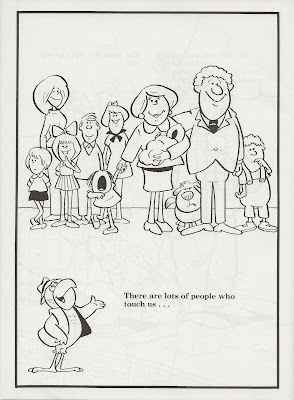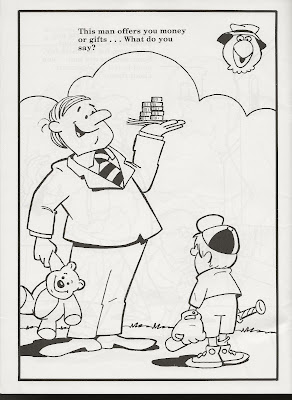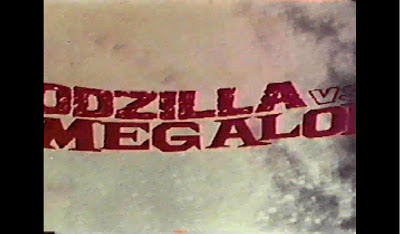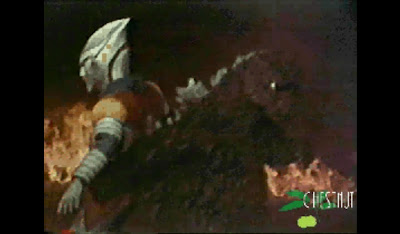I was lucky enough to acquire several pieces of production artwork from the original Hanna-Barbera GODZILLA show, and as it turns out, they are all from the very same episode, which was Episode 26 - THE DEADLY ASTEROID. Not only is this episode from the still-shamefully-unreleased-on-home-video-to-this-day second season, but it's also the very last episode!
The gallery that I purchased these pieces from (see end of post for info) showed screenshots from where a couple of the backgrounds were actually used in the finished show, and this inspired me to find the rest of the pieces as well, which was a fun scavenger hunt through this episode, which we can now look at together.
But first, you should have a rundown of the plot, for context. This is a very SUPERFRIENDS-like episode, because the crew of the Calico finds a UFO that's landed in the Arctic, and it's full of ice aliens from the planet Frios who attempt to use a ray to grab an asteroid (I think planetoid is a better word) that looks similar to the Moon, and pull it towards the Earth, causing general chaos and attempting to create another Ice Age (not the terrible CGI movie).
 |
| The leader of the aliens is even voiced by Stan Jones, who was always Lex Luthor, so there you go. |
Now that we have established the story, our first background painting comes from early in the episode, where the crew has launched a submarine from the Calico in an effort to go deeper into the icy waters, where they discover the UFO. Here is the background for the interior of the mini-sub:
And, here is the way it was ever-so-briefly used in the episode:
Likewise for the next piece, which is the front window of the sub, and is actually a background painting with most of the right side completely cut away! An unpainted cel is glued behind it, which you can see below:
Instead of being coded as "BG" for background, it's coded as "UL" for underlay, which is extremely interesting, because here is how it was actually used in the finished episode:
Pete and Dr. Darien are looking at frozen sea life, but everything outside of the window is simply black. It appears that animation below this background was intended but never used, either for reasons of time or cost, or perhaps both?
After the crew disembarks in a giant ice cave, they discover the UFO and peer through its icy window. This was accomplished with three layers, the topmost being the inner wall of the UFO:
Which looked like this when it was all put together:
-02.jpg) |
| If only that group cel still existed somewhere! |
Captain Majors ends up producing a screwdriver and unscrewing the screws (luckily for us, even aliens use flathead screws) on a grating, allowing he and Darien to enter the UFO. What's really interesting is this next piece, which I could find nowhere in my three studious scourings of this episode:
You'll notice it's coded as "OL" for overlay, which tells me the original plan was to have our heroes see the aliens at work through the grating, which was deemed too difficult or expensive, and therefore just skipped. Also notice that it definitely belongs to the show, because it's coded 124-26 (124 being the production number for the series, and the 26th episode).
Majors and Darien enter the UFO, encounter the aliens, and get chased around, where the following cels are used:
This overlay looks like this in the finished product:
And here is another console that I didn't even catch at first, because it's actually covered up by the animation in this case (hence UL for
underlay):
By the way, every time I type the word "underlay," all I can think of is this:
 |
| Underlay! Underlay! |
Back to the story...Pete, Brock, and Godzooky are left outside in the ice cave, where the aliens attack and freeze everyone but Pete, who is hiding behind a frozen structure:
This overlay seems incredibly lackluster at first glance, but it must've been deemed necessary to cover something up, or enhance it, because here it is in the finished episode:
Notice that the cel says "OLUL" for both, and I think that's because it was actually in the middle, here. If you look closely, you can see that Pete's hand is actually overlapping the shaded spots in the ice.
The aliens do manage to pull the planetoid down somewhat, at least close enough to destroy several world landmarks and screw up the oceans (again, a very SUPERFRIENDS move, but in that show, you always knew that Superman would undo whatever happened, and in his sleep, even). However, they are thwarted (of course) by the crew of The Calico, with a little help from Godzilla. Speaking of Godzilla, he actually does precious little in this episode, but I've saved the best for last.
There is one sequence--the second time he is summoned--where Godzilla has to punch through a solid mountain of ice to get to his friends. This was accomplished by layering translucent airbrushed overlay cels, and looks pretty awesome in the episode. And here are those very cels:
Looking like this in the finished product:
Perhaps someday this complete animated series will finally get the proper release that it deserves, which will allow us some clearer screenshots. Toho is in the midst of uploading the episodes to YouTube (strangely, divided into thirds) so we will see what happens.
Lastly, I didn't want to conclude this post without mentioning the Charles Scott Gallery in Agoura Hills, California, who sold me some of the amazing pieces shown above (and still have the rest available for sale!). Not only do they have a giant inventory of all types of animation artwork (
over 6,700 pieces on Ebay!), comic-related art, and more, but the folks I dealt with were some of the nicest and most professional that you could imagine. I had an issue with my first order, and they went out of their way to make it right. If you're looking to own a piece of your favorite movie, cartoon, or animated series, check out their massive inventory; you won't be disappointed!





.jpg)
.jpg)
.jpg)

















-01.jpg)
-02.jpg)
-01.jpg)
both.jpg)
-01.jpg)
-02.jpg)
%20unused.jpg)
-01.jpg)
-02.jpg)
-01.jpg)
-02.jpg)

-01.jpg)
-02.jpg)
-02.jpg)
-01.jpg)
-03.jpg)